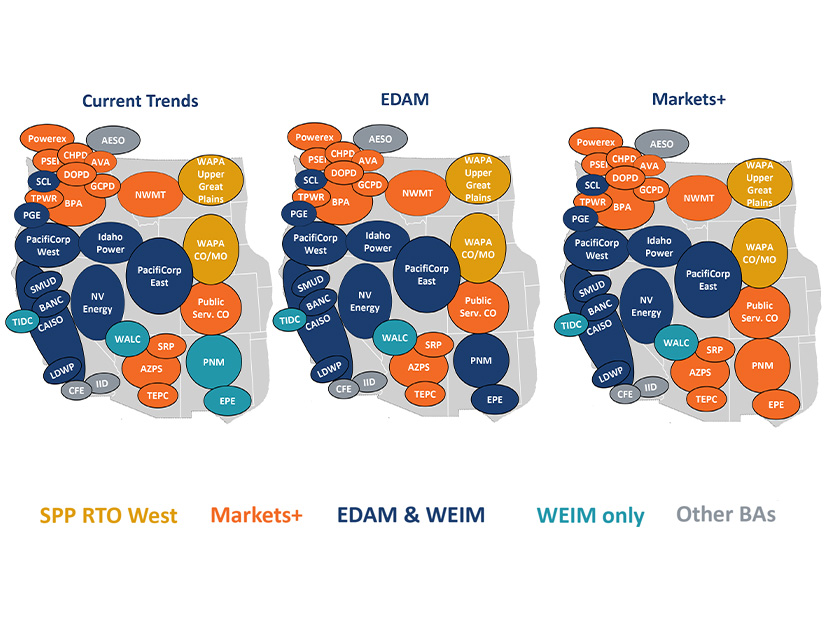
A new study may dispel the notion that New Mexico utilities must follow the day-ahead market choice of their Arizona counterparts in order to realize benefits from market participation.
The Brattle Group performed the study for Public Service Company of New Mexico (PNM) and El Paso Electric (EPE). It compared the projected benefits from joining either CAISO’s Extended Day-Ahead Market (EDAM) or SPP’s Markets+. The study models a scenario in which three Arizona utilities — Arizona Public Service, Salt River Project and Tucson Electric Power (TEP) — join Markets+.
Brattle Principal John Tsoukalis presented the study results Aug. 29 during a New Mexico Public Regulation Commission workshop.
PNM’s annual benefits would be $20.5 million in the EDAM case, the study found, compared with $8 million from participating in SPP’s Markets+. For EPE, projected benefits are $19.1 million a year for EDAM, versus $9.1 million for Markets+.
Compared to previous analyses, the new study modeled transmission connectivity in the two day-ahead market options in much more detail, including how third-party transmission rights could be used, according to Kelsey Martinez, PNM’s director of regional markets and transmission strategy.
“What we realized through this study is that we do have a choice,” Martinez told the commission.
That realization means that factors not included in the study may become more influential in PNM’s market choice, Martinez said. She noted the potential operational challenge of having large amounts of wind energy moving through the PNM system.
“One market would be dispatching our resources, and another market would be dispatching all the resources that are using and connected to our system,” she said.
Comparing Seams
Tsoukalis said the study was designed to look at the impact of two potential seams resulting from a day-ahead market choice.
“One of those key study questions was looking at which seam was worse,” he said: “that seam with Arizona, or the seam with all the wind in New Mexico that has off-takers in California?”
Brattle looked at the results of the New Mexico utilities joining EDAM or Markets+ as compared to a “current trends” case, which is “a representation of where we think the WECC could go,” Tsoukalis said.
In the current trends case, the Arizona utilities join Markets+ along with a cluster of Northwestern entities, including the Bonneville Power Administration, Powerex and Puget Sound Energy. Western Area Power Administration (WAPA) Upper Great Plains and WAPA Colorado Missouri go with SPP’s RTO West in the scenario.
Entities including CAISO, PacifiCorp, NV Energy, Portland General Electric and Idaho Power would participate in EDAM in the current trends case, while PNM and EPE would remain in CAISO’s real-time Western Energy Imbalance Market (WEIM) but would not join a day-ahead market.
Brattle chose 2032 as the study year.
The study found that for PNM, adjusted production costs fall from $55.4 million in the current trends case to $45.4 million in EDAM and $43.9 million per year in Markets+.
Annual congestion revenues are higher in the EDAM case, at $25.6 million for day-ahead and real-time markets combined, compared with $14.3 million in the Markets+ case. Bilateral trading revenue in EDAM is $3.3 million compared to $0.7 million in Markets+, a reduction from $8.6 million in the current trends case.
EPE also sees a difference in congestion revenues between the two cases: $16 million in EDAM versus $12.5 million in Markets+, relative to $7.8 million in the current trends case. EDAM also gives EPE a big potential boost to bilateral trading revenue: $14.4 million a year in EDAM compared to $6.6 million in the current trends case. Bilateral trading revenue drops to zero in the Markets+ case.
Because of increased imports from the Four Corners trading hub in the EDAM case, New Mexico “becomes flush with low-cost power,” Tsoukalis said. EPE then has an opportunity to sell that power to TEP in the Markets+ footprint.
In response to a commission question, Tsoukalis said Brattle did not study a case in which TEP or the other Arizona utilities joined EDAM, saying the results would be almost a “no-brainer.”
“I tend to think it would skew the benefits more for EDAM, of course, by adding more to that footprint,” he said.
Building Transmission
Scott Dunbar, a partner with Keyes & Fox representing the Clean Energy Buyers Association, asked whether congestion revenues projected for the New Mexico utilities in the EDAM case were likely to fall as new transmission is built.
Tsoukalis said the congestion revenue is a signal that more transmission, or greater availability of transmission rights, would be valuable. He said more transmission would shift a number of metrics.
“If you build more transmission, my intuition would be that benefits would go up overall,” Tsoukalis said. “It just might shift from congestion revenue to adjusted production cost reduction.”
Emmanuel Villalobos, EPE’s director of market development and resource strategy, said the company is still reviewing details of the Brattle study. But a big takeaway was the $14 million in potential revenue from bilateral trading in the EDAM case.
“[It’s] really enough to kind of sway [us] back and forth between the EDAM decision and the Markets+ decision,” he said, noting the figure was potential revenue and not guaranteed.
EPE will weigh other factors such as governance and start-up costs in its day-ahead market decision. And the company may ask Brattle for analysis of additional scenarios, which could include EPE and PNM choosing different markets.
The PRC’s Aug. 28 meeting was the third workshop the commission has held on regional markets. Commissioner Gabriel Aguilera said he now plans to work with his staff on a set of guiding principles for market participation, which will come to the full commission for a vote.


